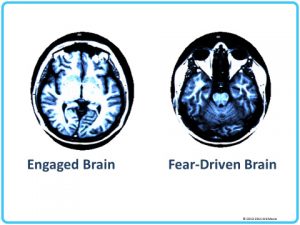The topic of climate change in Houston has been known to cause some ‘heated’ discussions on both sides of the issue, but what does this really have to do with you if you are, say, nearing retirement and considering options for the next phase of your life? Like the “big picture” topic of climate change, thinking about getting older in your home is not something that makes you or anyone else happy. Just the opposite – it brings on fear of the future. Have you ever said, or even thought, the following?
“It’s easier to stay in this house the way it is and do nothing, than to even think about getting older and being able to function here in 20 years.”
As an architect, I look at problems differently. That’s why I’m able to help people find creative ways to adapt their home for the future. But YOU are the one who needs to take the first step and that’s hard with a topic so connected to worry, fear and dread. It might even be more palatable to talk about that big picture topic of climate change than to think about how your life might change in 10 or 20 years! Don’t worry, there is actually something to learn from the global topic of climate change that can help us when it comes to aging in place …
- The word “climate” has a lot of surprising synonyms that we NEVER hear in connection with global climate change, for example: mood, spirit and ambiance. How do you want to FEEL in your home? What is the mood and spirit with which you want to live the rest of your life? What sort of ambiance do you want? Now, picture that in your mind!
- Just as with the big picture topic of climate change, if you plan ahead, you can be prepared. As architects we can offer other options and possibilities so that your home continues to provide a climate you enjoy being in.
- Let’s acknowledge that aging in place seems like a daunting problem, and you don’t want to think about it until you absolutely have to, but as with global climate change, time only makes it an even bigger problem.
- Nobody wants options forced upon them — “do this or there will be gloom and doom!” — and that is a big part of the resistance to climate change discussions, especially in the political arena. But as specialists in aging in place and invisible design, we can help you change the conversation. What if you intentionally change your climate, in a way that you are able to better enjoy and maintain your personal environment and your lifestyle?
- Rather than approaching the topic of climate change as “This is what we are losing…”, consider: What might be gained by a team of people working together over time? Thinking this way brings a positive spirit, whether you are talking about the planet or your neighborhood or your home. If you make intentional, incremental changes to adapt to different aspects of your lifestyle, you will avoid a cataclysmic event. And you won’t be losing anything. With proper planning, you will actually ADD value to your home, growing what is considered by most people to be their largest investment. Make these changes gradually, with intention and a positive mindset. Maintain your quality of life. The result is a win-win: you get functionality for when you need it combined withthe aesthetics and style that reflect how you live and what you love.
- As with global climate change, this topic is also largely about energy. One of the climate synonyms, “ambiance,” translates as an inner glow — it’s about yourlife and the glow of your It’s your own energy and attitude toward life, your excitement put into physical form, creating an environment that reflects the way you want to live and makes it possible to continue doing what you love with ease.
- Just like the big issue of climate change, it’s easier to continue with things as they are and NOT take the first step toward living differently. But there are SO MANY EASY THINGS you can do now to make your life better in the future. We can help. Start by asking yourself, what makes you glow? I’d love to hear your answer, because that answer is the first step on the roadmap to creating the best solutions for your future.
Finally, much like global climate change, you may feel quite comfortable in your home today, even knowing that a storm could be on the horizon. But like everyone else, you are getting older. Maybe you are even thinking about having an aging parent move in with you. Isn’t it time to consider changing the climate of your life? I understand – you don’t want to completely disrupt your household – logistically, emotionally or financially. You may love the atmosphere just the way it is. But your home’s function can affect your mood and dictate your daily activities. Its functionality (or lack of) will mandate, “This is how you feel.” Think about how you would feel if you were unable to enjoy your favorite pastime or forced to limit your social activities with family and friends. Then, let’s have our own discussion about climate change … today.

















 According to acclaimed executive coach Eva Archer Smith, an expert in the field of transformation, “Your brain has enormous neuroplasticity, so you can rewire it to change. And it changes by actions, not thoughts.” She says that one of the fastest proven ways to move from the default setting of the ‘primitive’ or fear-based brain, which senses danger and releases the stress hormone, cortisol, to the pre-frontal cortex, which releases the feel-good hormone, oxytocin, is by practicing gratitude.
According to acclaimed executive coach Eva Archer Smith, an expert in the field of transformation, “Your brain has enormous neuroplasticity, so you can rewire it to change. And it changes by actions, not thoughts.” She says that one of the fastest proven ways to move from the default setting of the ‘primitive’ or fear-based brain, which senses danger and releases the stress hormone, cortisol, to the pre-frontal cortex, which releases the feel-good hormone, oxytocin, is by practicing gratitude.

 One set of clients, Ann and John, purchased a lot near a golf course but far from the family they loved inviting for holiday celebrations. Another client, Cindy, was thinking of moving into an assisted living center but was dreading giving up her garden. What Ann, John and Cindy had in common, I realized, was the idea that they must give something up in order to brace themselves for growing older.
One set of clients, Ann and John, purchased a lot near a golf course but far from the family they loved inviting for holiday celebrations. Another client, Cindy, was thinking of moving into an assisted living center but was dreading giving up her garden. What Ann, John and Cindy had in common, I realized, was the idea that they must give something up in order to brace themselves for growing older.